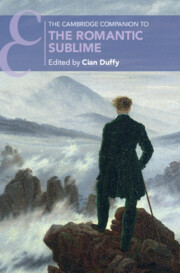Book contents
- The Cambridge Companion to the Romantic Sublime
- The Cambridge Companion to the Romantic Sublime
- Copyright page
- Contents
- Figures
- Contributors
- Abbreviations
- Introduction
- Part I The Sublime before Romanticism
- Part II Romantic Sublimes
- 5 German Romanticism and the Sublime
- 6 The Romantic Sublime and Kant’s Critical Philosophy
- 7 Alpine Sublimes
- 8 Urban Sublimes
- 9 Highlands, Lakes, Wales
- 10 Science and the Sublime
- 11 Musical Sublimes
- 12 The Arctic Sublime
- 13 The Body and the Sublime
- 14 The Sublime in Romantic Painting
- 15 From the Sublime to the Ridiculous
- 16 The Sublime in American Romanticism
- Part III Legacies
- Further Reading
- Index
- Cambridge Companions To …
6 - The Romantic Sublime and Kant’s Critical Philosophy
from Part II - Romantic Sublimes
Published online by Cambridge University Press: 06 July 2023
- The Cambridge Companion to the Romantic Sublime
- The Cambridge Companion to the Romantic Sublime
- Copyright page
- Contents
- Figures
- Contributors
- Abbreviations
- Introduction
- Part I The Sublime before Romanticism
- Part II Romantic Sublimes
- 5 German Romanticism and the Sublime
- 6 The Romantic Sublime and Kant’s Critical Philosophy
- 7 Alpine Sublimes
- 8 Urban Sublimes
- 9 Highlands, Lakes, Wales
- 10 Science and the Sublime
- 11 Musical Sublimes
- 12 The Arctic Sublime
- 13 The Body and the Sublime
- 14 The Sublime in Romantic Painting
- 15 From the Sublime to the Ridiculous
- 16 The Sublime in American Romanticism
- Part III Legacies
- Further Reading
- Index
- Cambridge Companions To …
Summary
This chapter examines the ‘Critical sublime’ as developed by Kant in the ‘Analytic of the Sublime’ in his Kritik der Urteilskraft. It interprets Kant as adumbrating three features that later become central tropes of the Romantic characterization of sublimity: the sense that its source and ultimate value lie beyond everyday experience; that it involves the subject, rather than any external object, as the immediate and direct object of consciousness; and that the paradigmatically natural phenomena and their qualities that ostensibly excite the experience are less important than the contemplative relationship one takes to them. Consideration of each in turn gives the chapter its narrative structure and divides it into three main sections, ‘Transcendence and the Phenomenal Self’, ‘The Moral Subject Within’, and ‘The “Objects” of Nature and Art’. The discussion concludes with a brief observation on the proto-Romantic sentiment that Kant expresses in his view of poetry and the arts.
- Type
- Chapter
- Information
- The Cambridge Companion to the Romantic Sublime , pp. 81 - 91Publisher: Cambridge University PressPrint publication year: 2023

